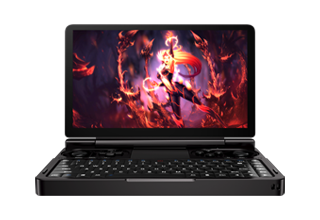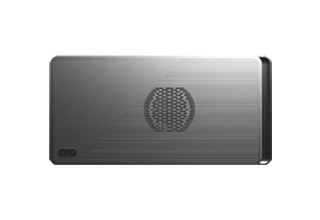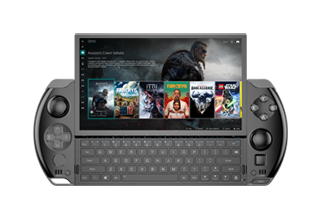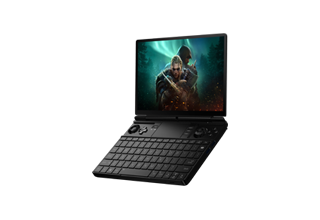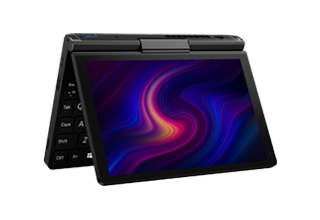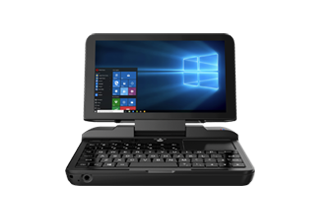GPD DUO ports and configuration, a bit of a brain-burner, but will definitely let you understand where it is better than its competitors!

Test your eyesight, everyone. How many ports can you find from the picture above? Given that players are all looking forward to the configuration, this issue will cover ports and configurations together. It may seem a bit confusing, but it is not difficult to understand!
GPD DUO configuration
AMD Ryzen™ AI 9 HX 370 processor

GPD DUO uses the latest AMD Ryzen AI 9 HX 370 processor, codenamed Strix Point! This upgrade will greatly improve the overall computing power and gaming performance of GPD DUO.
AI 9 HX 370 processor, codenamed Strix Point! This upgrade will greatly improve the overall computing power and gaming performance of GPD DUO.
AMD Ryzen AI 9 HX 370 is based on the brand-new Zen5 architecture, 4nm process technology, 12 cores and 24 threads, with a total cache of up to 36.75 MB, a turbo frequency of 5.1GHz, and a total computing power of 80 TOPS.
AI 9 HX 370 is based on the brand-new Zen5 architecture, 4nm process technology, 12 cores and 24 threads, with a total cache of up to 36.75 MB, a turbo frequency of 5.1GHz, and a total computing power of 80 TOPS.

In the Cinebench 2024 test, the single-core performance is basically on par with the desktop AMD Ryzen 9 7950X, and the multi-core performance is comparable to the desktop AMD Ryzen 9 5950X.
The overall computing power of 80 TOPS even surpasses the previous generation of mobile standard voltage U AMD Ryzen 7 8840HS and Intel's top mobile Intel Core Ultra 9 processor 185H.
The RDNA 3.5 architecture AMD Radeon 890M core display, 16CU integrated 1024 stream processors, the specifications are 33% higher than the previous generation, and the game performance is increased by 36%! Combined with LPDDR5x 7500 MT/s memory, the video memory bandwidth is also increased synchronously.

The 3DMark - TimeSpy graphics card score surpasses the NVIDIA GeForce RTX 2050 (mobile version) and is close to the NVIDIA GeForce RTX 3050 (mobile version).

The XDNA 2 architecture NPU enhances computational efficiency and reduces overall power consumption, making local AI tasks like image background removal faster and more efficient.

With a NPU computing power of 50 TOPS, it is 5 TOPS higher than Qualcomm Snapdragon X Elite and 12 TOPS higher than Apple M4 (10-CPU), making it the strongest NPU in the current rankings.
AMD's new XDNA 2 architecture NPU is 3 times the computing power of the previous generation NPU. Combined with CPU and GPU, the total computing power is as high as 80 TOPS, far exceeding the 40 TOPS computing power standard of AI PCs.
The Oculink (SFF-8612) female port integrated in GPD DUO provides PCIe direct connection, 63Gbps effective bandwidth, and supports eGFX devices including GPD G1. The total computing power of 108 TOPS provides excellent performance for personal AI processing and creates the strongest gaming experience for gamers on mobile devices.
Dual-channel LPDDR5x 7500 MT/s memory
Optional: 16GB / 32GB / 64GB

GPD DUO uses LPDDR5x 7500MT/s memory, with three optional capacities of 16GB/32GB/64GB. The maximum capacity that can be allocated to the video memory is up to 16GB, allowing AI applications that require large video memory to be fully utilized. When playing games, there is no need to worry about memory overflow, and the game is smoother. During crowdfunding and pre-sales, the memory may be increased to a 96GB version, with only 16GB/32GB/64GB versions available at retail.
Dual fans, dual heat pipes, hurricane cooling
Factory default 35W TDP, up to 60W, extreme performance release

Adopting a dual heat pipe distribution design, equipped with dual fans, large-volume turbine air supply, all-round heat dissipation, keeping cool continuously, and releasing extreme performance for you!

2 M.2 ports
Optional: 512GB / 2TB / 4TB × 1

The GPD DUO design adopts 2 M.2 ports, both of which are PCIe 4.0 × 4 bus specifications, supporting 2280 specification single-sided SSD. At present, the largest capacity on the market is 8TB, so the body can be expanded to a maximum of 16TB (8TB + 8TB), with no capacity limit.
During crowdfunding and pre-sales, the SSD may be increased to an 8TB (4TB + 4TB) version, that is, a 96GB + 8TB version. The retail version will only have 512GB/2TB/4TB × 1 version, and one M.2 port will be left empty.
80Wh ultra-large capacity battery
1080P video continuous playback for 30 hours

After testing, when the single screen brightness is set to 150nits, the screen refresh rate is set to 60Hz, the silent mode is fully charged, the Bluetooth is turned off, the network is disconnected (Wi-Fi, RJ45), and the headphones are used, the local 1080P video can be played for up to 30.2 hours.
Comparison of dual-screen product parameters
As players know, in addition to GPD DUO, there are also ASUS Lingyao 14 and Lenovo YOGA Book 9i for dual-screen products. The difference between GPD DUO and these two is the integrated three-stage design, and the screen is not integrated with the fuselage.
In terms of processors, the top version of ASUS Lingyao 14 uses Intel Core
Core Ultra 9 processor 185H. Lenovo YOGA Book 9i uses Intel
Ultra 9 processor 185H. Lenovo YOGA Book 9i uses Intel Core
Core i7-1355U, and recently upgraded Intel
i7-1355U, and recently upgraded Intel Core
Core Ultra 7 processor 155H, which is only available during the pre-sale period.
Ultra 7 processor 155H, which is only available during the pre-sale period.
The highest pressure of ASUS Lingyao 14 is only 35W TDP, but the minimum power consumption required by 185H is also 35W, the basic power consumption is 45W, and the highest can reach 115W.
Lenovo YOGA Book 9i 1335U version can only go up to 15W at most, which is only the basic design power consumption, but if it is a product with good heat dissipation, 1335U can reach 55W. In order to be ultra-thin, Lenovo's product can only be suppressed to 15W TDP at most.
After Lenovo YOGA Book 9i replaced 155H, it is still the original mold, and it is difficult to improve the heat dissipation. The basic power consumption required by 155H is 28W, the maximum turbo power consumption is 115W, and the minimum guaranteed power consumption is 20W. There are several evaluation videos on the Internet that avoid this topic, and there is no mention of details, so it is very likely that the default factory setting of this product is 20W. It is estimated that it will overheat, crash and become hot if it goes up to 28W.
The common problems of these two products: they both sacrifice heat dissipation and performance for the sake of being ultra-thin. In my opinion, Asus and Lenovo's products are a waste of a CPU, and the price of tens of thousands is about the same as the performance of GPD Mini.
The following is a comparison of the TDPs of the four products:
| Product | Default TDP | Maximum TDP |
|---|---|---|
| GPD DUO (AI 9 HX 370) | 35W | 60W |
| ASUS Lingyao 14 (185H) | Unknown | 35W |
| Lenovo YOGA Book 9i (155H) | Unknown | Unknown |
| Lenovo YOGA Book 9i (1335U) | 15W | 15W |
The following is a comparison of the computing power of the four processors:
| Computing Power | AI 9 HX 370 | 185H | 155H | 1335U |
|---|---|---|---|---|
| NPU Computing Power | 50 TOPS | 11 TOPS | 11 TOPS | None |
| GPU Computing Power | 23 TOPS | 18 TOPS | 18 TOPS | 13 TOPS |
| CPU Computing Power | 7 TOPS | 7 TOPS | 6 TOPS | 4 TOPS |
| Total Computing Power | 80 TOPS | 36 TOPS | 35 TOPS | 17 TOPS |
The following is a comparison of the floating-point performance of the integrated graphics of the four products:
| Product | FP16 | FP32 | FP64 |
|---|---|---|---|
| GPD DUO (AI 9 HX 370) | 17.82 TFlops | 8.92 TFlops | 556.8 GFlops |
| ASUS Lingyao 14 (185H) | 9.216 Tflops | 4.608 Tflops | None |
| YOGA Book 9i (155H) | 9.216 Tflops | 4.608 Tflops | None |
| YOGA Book 9i (1335U) | 3.994 Tflops | 1.997 Tflops | None |
Since the 13th generation of Intel Core processors, the company has removed the double-precision (FP64) units from the integrated graphics, resulting in a lack of FP64 data capabilities. This trend continues even in the Intel Core Ultra series, where the integrated Xe-HPG microarchitecture still lacks the FP64 functionality.
While the number of stream processors has increased, the gaming performance of Intel's integrated graphics is still not on par with the 780M discrete graphics, even when the TDP is set to 28W to match the 780M's 15W TDP. Additionally, Intel has removed the AVX-512 instruction set, which severely limits the performance of Intel's integrated graphics when running emulator-based games that rely on this instruction set.
Here is a comparison of the memory specifications for four products:
| Product | Memory Capacity | Memory Type |
| GPD DUO (AI 9 HX 370) | 16GB / 32GB / 64GB / 96GB(TBD) | LPDDR5x 7500MT/s |
| ASUS Zenbook 14 OLED (185H) | 32GB | LPDDR5/x 7467 MT/s |
| YOGA Book 9i (155H) | 32GB | LPDDR5/x 7467 MT/s |
| YOGA Book 9i (1335U) | 16GB | LPDDR5x 6400 MT/s |
The following is a comparison of the storage of the four products:
| Product | Default Capacity | Bus Specification |
| GPD DUO (AI 9 HX 370) | 512GB / 2TB / 4TB / 8TB (TBD) | PCIe 4.0 × 4 |
| ASUS Zenbook 14 OLED (185H) | 2TB | PCIe 4.0 × 4 |
| YOGA Book 9i (155H) | 1TB | PCIe 4.0 × 4 |
| YOGA Book 9i (1335U) | 1TB | PCIe 4.0 × 4 |
The following is a comparison of the screens:
| Parameter | GPD DUO | ASUS Zenbook 14 OLED (185H) | YOGA Book 9i |
| Touch | Support dual screen | Support dual screen | Support dual screen |
| Stylus | Support, mpp protocol | Support, mpp protocol | Support, mpp protocol |
| Screen size | 13.3 × 2 | 14 × 2 | 13.3 × 2 |
| Screen resolution | 2880×1800 | 2880×1800 | 2880×1800 |
| Display ratio | 16:10 | 16:10 | 16:10 |
| Refresh rate | 60Hz | 120Hz | 60Hz |
| Pixel density | 255ppi | 242ppi | 255ppi |
| Color depth | 10bit, 1.07 billion colors | 10bit, 1.07 billion colors | 10bit, 1.07 billion colors |
| Color accuracy | ΔE < 1 | ΔE < 1 | ΔE < 1 |
| Color Gamut |
sRGB:133% NTSC:96% Adobe RGB:100% DCI-P3:100% |
sRGB:100% NTSC:72% Adobe RGB:92% DCI-P3:100% |
sRGB:100% NTSC:72% Adobe RGB:96% DCI-P3:100% |
| Peak brightness | 500 cd/m² | 550 cd/m² | 400 cd/m² |
| Grey To Grey | 1ms | 0.8ms | 2ms |
| Secondary screen input | Support | Not supported | Not supported |
Comparison of battery capacity:
| Parameter | GPD DUO | ASUS Zenbook 14 OLED (185H) | YOGA Book 9i |
| Capacity | 80Wh | 75Wh | 80Wh |
| Battery life | 14 hours, up to 30.2 hours | 13 hours | 14 hours |
GPD DUO ports and function keys
1 Oculink and 1 USB4 port

GPD DUO integrates an Oculink (SFF-8612) female port and a USB4 port, supporting the officially launched GPD G1 mobile graphics card expansion dock and Oculink (SFF-8611) dual-male cable. One of the purposes of integrating these two ports is to expand the external graphics card. Users of GPD G1 all know how to use it, so I won't go into details here. Friends who are interested in GPD G1 can visit https://gpd.hk/gpdg1graphics to learn more!
The USB4 full-featured port has a bandwidth of 40Gbps and supports 100W PD protocol fast charging, data transmission, as well as video and audio signal transmission. It supports DP 2.1 and UHBR10 transmission modes, and the maximum resolution output of the supported display is: 3840x2160/240Hz or 7680x4320/60Hz.

The overall computing power of GPD DUO + GDP G1 reaches 108 TOPS! Among them: GPD G1 based on 64 AI accelerators provides 28 TOPS of computing power, AMD Ryzen™ AI 9 HX 370's AI acceleration core NPU provides 50 TOPS of computing power, 890M graphics card provides 23 TOPS of computing power, and CPU provides 7 TOPS of computing power. This combination provides the strongest computing power for the next generation of Windows with a large number of AI technologies.
Secondary screen 1 USB-C (DP Alt Mode only)

The USB C port on the secondary screen only supports DP ALT Mode (video signal), does not support audio, does not support data transmission, and supports charging mode switching. The purpose of designing it is to use the secondary screen as the main screen or extended screen of a third-party main device, and the sound depends on the external speaker of the third-party main device.
Third-party main devices can be devices such as mobile phones, tablets, handhelds, game consoles, PC hosts, laptops, NUCs, UMPCs, etc. that have any of the following ports, and require the following types of cables to support:
- Full-featured USB-C port. Currently, devices that claim to have a full-featured USB-C port basically support DP ALT Mode. The connection method is very simple, just a full-featured USB-C cable.
- Full-featured USB-C port, based on HDMI ALT Mode, requires a conversion cable. Very few devices support this port, and the HDMI ALT Mode specification is about to die. If your device is based on this type of port, you will need a dual-male USB C conversion cable with HDMI ALT Mode at the input end and DP ALT Mode at the output end, which has HDMI to DP signal conversion function. This kind of cable is hard to find.
- DP (or Mini DP) port. A DP (or Mini DP) to USB-C cable is required for connection.
- HDMI (or Mini HDMI, Micro HDMI), but a signal conversion cable is required, that is, a cable with HDMI (or Mini HDMI, Micro HDMI) at the input end and USB-C at the output end, and with HDMI to DP signal conversion function. As shown in the figure below, this type of cable is mainly used for PS5 or Xbox SS/SX to connect to a portable screen. You can find it by searching for the keyword "HDMI to Type-C video cable PS5 Xbox connection".


Or a converter like the one below that converts the HDMI signal to a DP signal.

When connecting to a mobile phone:
If the mobile phone has TV mode, it will directly output the PC desktop. If not, it will directly output the mobile phone desktop with large black borders on the top and bottom.

Not all mobile phones support connecting to a secondary screen. Whether it is supported or not depends on whether the mobile phone's USB C has DP ALT Mode or TV-out function. Notes:
- The USB-C cable used for connection must support full functions. When connecting to a mobile phone with TV-out or DP ALT Mode function, the mobile phone outputs different desktops to the secondary screen depending on whether it supports PC mode.
- Regarding the TV-out function, it is just a concept packaged by Qualcomm after launching the Snapdragon 835 SoC. It is essentially DP 1.4 technology.
- Not all mobile phones support TV-out or DP ALT Mode function. Not all mobile phones that support TV-out or DP ALT Mode have PC mode. Please refer to the incomplete statistics appendix at the bottom of the official GPD DUO details page for support. Some Android phones or Android tablets require you to select "Mirror" or "Extend" mode to output. Please select according to the actual situation.
- The secondary screen does not support power supply to third-party main devices. When the GPD DUO is turned on, the secondary screen is powered by the GPD DUO when the mobile phone is connected. When the GPD DUO is turned off, the secondary screen is powered by the mobile phone.
- When the GPD DUO is turned off, not all mobile phones can power on the secondary screen. Whether it can be turned on or not depends on the power supply of the mobile phone's USB-C. At this time, the secondary screen cannot guarantee the maximum brightness, and the brightness of the secondary screen also depends on the power supply of the mobile phone.
When connecting to a handheld:

Usually the secondary screen can be powered on. GPD handhelds have supported full-featured USB C since WIN 3, and can be connected to this secondary screen. In addition, third-party devices such as Switch and Steam Deck are also supported. And you can directly connect Switch with one cable, no need for a dock, you can directly open TV mode.
When connecting to the host:
PS5 (CFI-1000, CFI-1100, CFI-1200), PS5 Slim (CFI-2000), PS5 Pro (although it is not yet on the market, it is not yet known whether it supports full-featured USB C, it should still be an HDMI port), Xbox Series X, Xbox Series S, etc. all provide only HDMI ports, and PS5 is updated to PS5 Slim, which is just an update for nothing.
As mentioned earlier, the secondary screen's USB C supports DP ALT Mode. Therefore, the host video signal needs to be converted from HDMI to DP signal through an HDMI to USB-C video cable or video converter before output.
Brightness adjustment keys on the secondary screen

This key is used to adjust the brightness of the secondary screen, and it is most suitable in tablet mode, making it convenient to adjust the screen brightness with one finger.
1 SD 4.0 slot

Most people are familiar with SD cards, and compared to the UHS-I bus speed limit of microSD cards, SD 4.0 supports UHS-II high-speed buses, which are nearly three times faster than microSDs. When shooting 4K/60Hz video, cameras and camcorders need to write faster, so they generally use SD or CF cards. Although GPD DUO does not provide a microSD card slot, you can use a microSD to SD card adapter to read the contents of microSDHC or microSDXC cards.

One RJ45 Ethernet port: 2.5 Gbps network card

GPD DUO comes with a built-in 2.5Gbps Ethernet card and integrates with an RJ45 port for faster and more stable internet, gaming, video playback, and file transfers. Additionally, it also supports Wi-Fi 6E wireless network card, which can easily handle various network environments. Its Bluetooth 5.3 supports the connection of up to 255 devices.

One full-featured USB-C 3.2 Gen2 port

This full-featured USB-C port is located next to the USB4 port and follows the USB 3.2 Gen2 specification. It has a bandwidth of 10Gbps and supports 100W PD fast charging, as well as data transmission and audio/video signal transmission.
Due to bandwidth limitations, DP Alt Mode only supports DP 1.4 and HBR3 transmission modes. To ensure bandwidth utilization, the full-featured USB-C cable should be less than 1 meter long. The maximum supported resolution is 3840 × 2160 @ 120Hz.
Two USB-A 3.2 Gen1 ports

Both ports support a 5Gbps bandwidth, and having two USB-A ports should be enough for daily use!
One HDMI port

It follows the HDMI 2.1 TMDS specification!
Since the graphics card only supports up to four displays, if the two built-in displays on the device are already connected, then using USB4, full-featured USB-C, and HDMI can connect a maximum of two additional displays. But if a GPD G1 is also connected, the maximum number of supported displays can reach up to seven.
Full-size backlit keyboard and precise touchpad (PTP mode)

The backlit keyboard can still be toggled on or off using the Fn+Spacebar combination. With a key travel of 1.3mm, typing on the keyboard is more comfortable, and the keys offer strong feedback and responsiveness, making it less tiring for extended periods of typing.
The touchpad supports up to 5-finger gestures and does not require a physical press. However, the left and right buttons provide haptic feedback, ensuring consistent tactile experience throughout the touchpad area.
The power button is actually located on the right side of the device, as shown in the image below. Next to the two USB-A ports is a combination fingerprint and power button, enabling one-touch power on and unlock functionality. The overall weight of the device is currently not available and will be announced later.

It supports a 2.5K high-definition webcam
making remote video communication convenient and efficient


It features DTS:X Ultra sound technology
allowing for true surround sound audio

The speakers are located on both sides of the device, and both the headphone jack and speakers support DTS:X Ultra sound technology, enabling simulated 7.1-channel audio.
These are the main ports and function keys explained! The interface diagram is shown below.

In the next installment, we will discuss the real-life applications of GPD DUO, and this will also be the final installment.
-
GPD Win Max 2 (2025) is a mini gaming laptop with Ryzen AI 9 HX 370
This week handheld PC maker GPD launched an updated version of its GPD Win 4 handheld gaming PC with a 6 inch display and an AMD Ryzen AI 9 HX 370 “Strix Point” processor, which should bring a significant performance boost over the Ryzen 7 8840U “Hawk Point” chip in the previous-generation model.
넶30 2024-12-17 -
GPD launches Win 4 handheld gaming PC with Ryzen AI 9 HX 370
The GPD Win 4 is a handheld gaming PC with a 6 inch FHD touchscreen display that slides upward to reveal a physical keyboard for thumb typing and a design that makes the handheld look like an oversized PlayStation Portable… if the PSP had a keyboard and support for modern PC games.
넶40 2024-12-17 -
GPD Pocket 4 is an 8.8 inch mini-laptop with up to AMD Ryzen AI 9 HX 370 (crowdfunding)
The GPD Pocket 4 is a mini-laptop with an 8.8 inch, 2560 x 1600 pixel, 144 Hz display, support for up to an AMD Ryzen AI 9 HX 370 “Strix Point” processor, and a convertible design that lets you twist the screen 180 degrees and fold it down over the keyboard for use in tablet mode.
넶37 2024-12-17 -
GPD announces official pricing for its Pocket 4 mini-laptops — The $1,466 unit packs 12-core Ryzen AI HX 370, 64GB of RAM, 2TB SSD, and 144Hz 2.5K display
Back in August, GPD announced the Pocket 4 mini laptop, which was supposedly the first handheld to employ AMD's latest Strix Point APUs. Following that, GPD Game Consoles has recently shared the pricing structure for these handhelds at X—starting at $895 with AMD's Zen 4-based Ryzen 7 8840U model and as high as $1,466 if you want the flagship Ryzen AI 9 HX 370 decked out with 64GB of RAM and 2TB of storage.
넶45 2024-12-13 -
GPD Duo Laptop Review: A Game-Changing Dual-Screen Powerhouse
In a world where innovation is key to staying ahead in technology, GPD has made a bold move with its latest offering—the GPD Duo, a dual-screen laptop powered by AMD’s cutting-edge Ryzen AI9 HX 370 processor. This is not your ordinary laptop. The dual-screen design, paired with top-tier specs and functionalities, makes the GPD Duo an exciting and versatile tool, particularly for professionals and tech enthusiasts. As a top content writer, I’ve seen how critical it is to balance innovation with
넶15 2024-12-13


